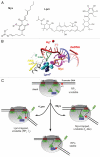Antibiotics trapping transcription initiation intermediates: To melt or to bend, what's first?
- PMID: 21468230
- PMCID: PMC3062395
- DOI: 10.4161/trns.2.2.14366
Antibiotics trapping transcription initiation intermediates: To melt or to bend, what's first?
Abstract
Promoter DNA melting, culminating in the loading of the single-stranded DNA template into the RNA polymerase active site, is a key step in transcription initiation. Recently, the first transcription inhibitors found to block distinct steps of promoter melting were characterized. Here, the impact of these studies is discussed with respect to the current models of transcription initiation.
Figures


Similar articles
-
Remodeling of the sigma70 subunit non-template DNA strand contacts during the final step of transcription initiation.J Mol Biol. 2005 Jul 29;350(5):930-7. doi: 10.1016/j.jmb.2005.05.048. J Mol Biol. 2005. PMID: 15978618
-
How to switch the motor on: RNA polymerase initiation steps at the single-molecule level.Protein Sci. 2017 Jul;26(7):1303-1313. doi: 10.1002/pro.3183. Epub 2017 May 12. Protein Sci. 2017. PMID: 28470684 Free PMC article. Review.
-
Kinetic and thermodynamic basis of promoter strength: multiple steps of transcription initiation by T7 RNA polymerase are modulated by the promoter sequence.Biochemistry. 2002 Mar 19;41(11):3586-95. doi: 10.1021/bi0158472. Biochemistry. 2002. PMID: 11888274
-
Multiple roles of the RNA polymerase {beta}' SW2 region in transcription initiation, promoter escape, and RNA elongation.Nucleic Acids Res. 2010 Sep;38(17):5784-96. doi: 10.1093/nar/gkq355. Epub 2010 May 10. Nucleic Acids Res. 2010. PMID: 20457751 Free PMC article.
-
Diverse and unified mechanisms of transcription initiation in bacteria.Nat Rev Microbiol. 2021 Feb;19(2):95-109. doi: 10.1038/s41579-020-00450-2. Epub 2020 Oct 29. Nat Rev Microbiol. 2021. PMID: 33122819 Free PMC article. Review.
Cited by
-
Conformational heterogeneity and bubble dynamics in single bacterial transcription initiation complexes.Nucleic Acids Res. 2018 Jan 25;46(2):677-688. doi: 10.1093/nar/gkx1146. Nucleic Acids Res. 2018. PMID: 29177430 Free PMC article.
-
Coupling of downstream RNA polymerase-promoter interactions with formation of catalytically competent transcription initiation complex.J Mol Biol. 2014 Dec 12;426(24):3973-3984. doi: 10.1016/j.jmb.2014.10.005. Epub 2014 Oct 13. J Mol Biol. 2014. PMID: 25311862 Free PMC article.
References
-
- Spassky A, Kirkegaard K, Buc H. Changes in the DNA structure of the lac UV5 promoter during formation of an open complex with Escherichia coli RNA polymerase. Biochemistry. 1985;24:2723–2731. - PubMed
LinkOut - more resources
Full Text Sources
